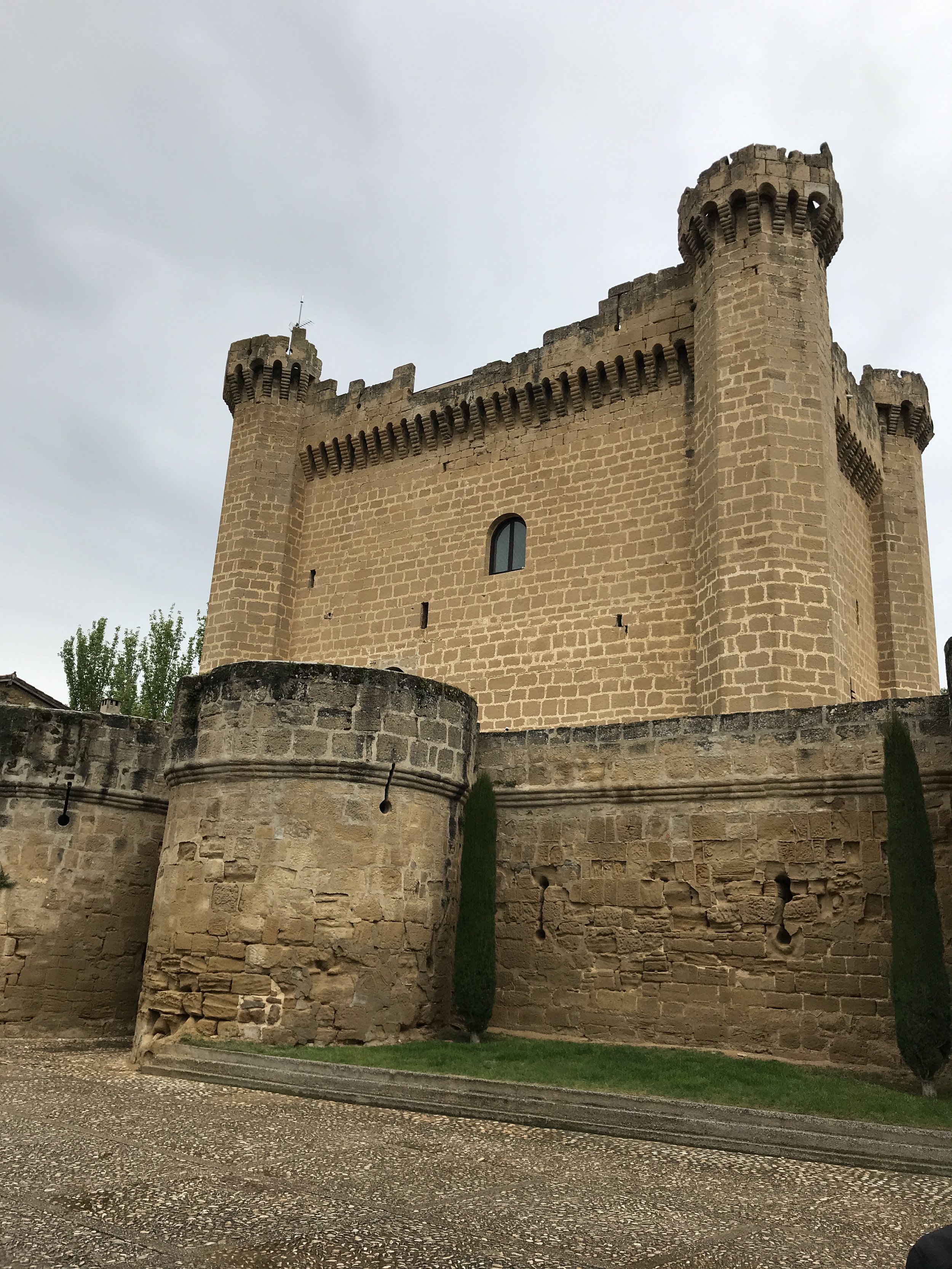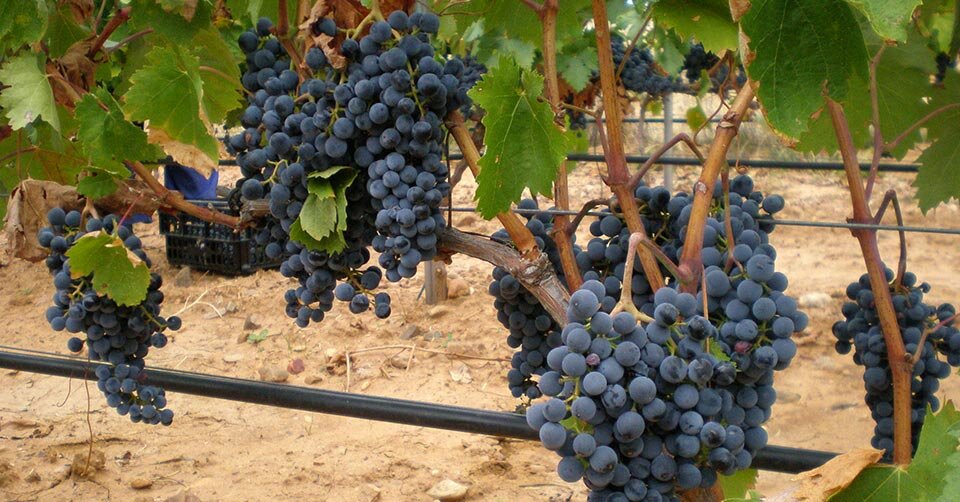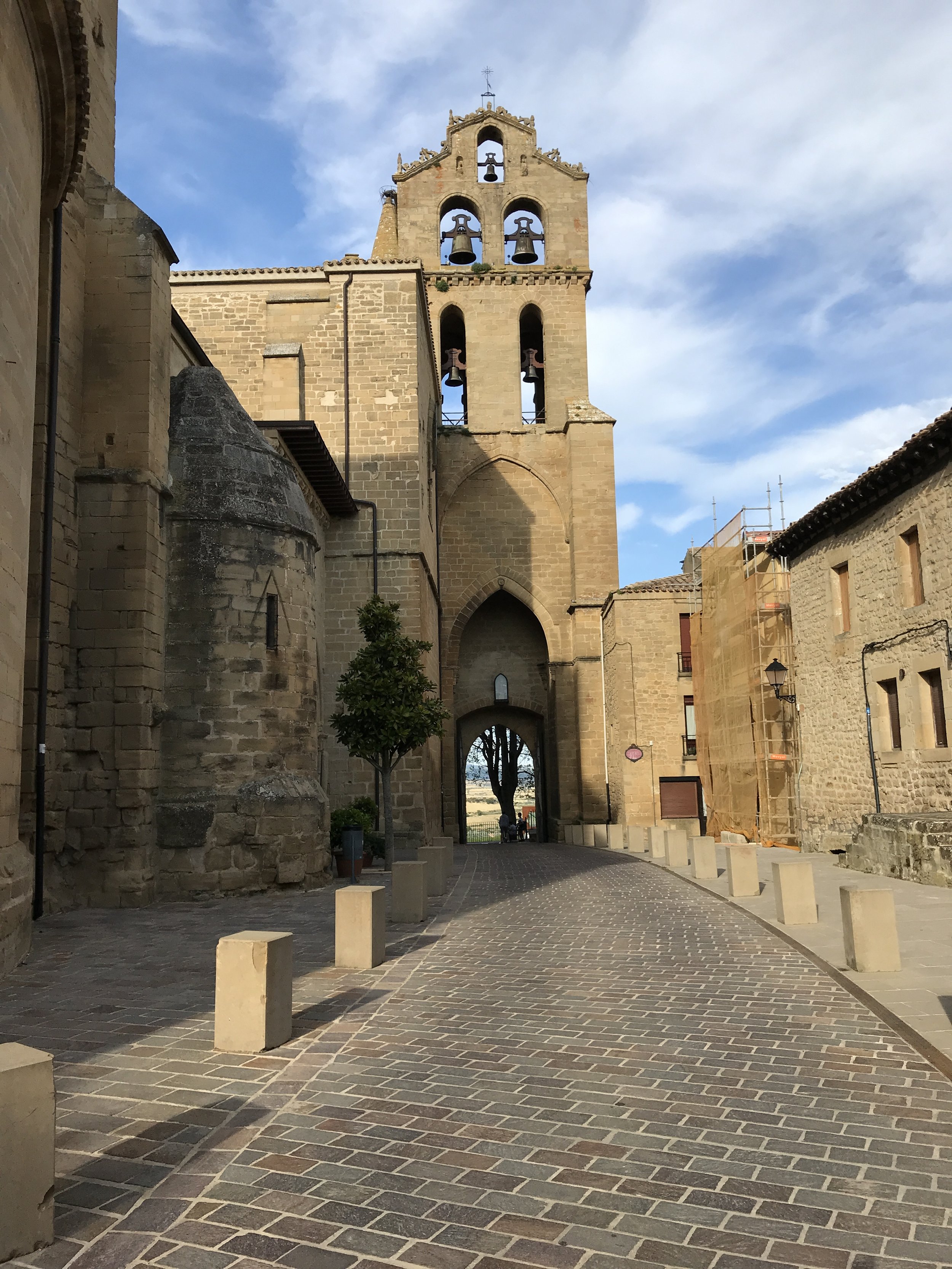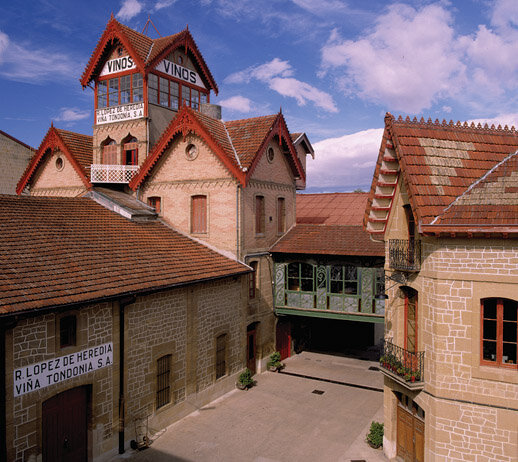Classic & Modern Wine & Cuisine in the Rioja
Rioja Wine Tour
Overview
Explore Rioja’s diversity of wines
This trip will take you deep into the wine, food and history of Rioja. You’ll visit wineries that show the quality of the wines from Spain’s legendary wine region, from styles that harken back a hundred years to new innovations happening now. From Haro’s Station Quarter to Laguardia, Ezcaray and Logroño, you’ll visit producers in corners of the region who make wine of local character and global quality. You’ll also visit towns and villages that show Rioja’s history and beauty, from hilltop Briones to mountainous Ezcaray and bustling Logroño. Along the way, you’ll taste the best of Riojan cuisine, whose fresh products and honesty make it a highlight in Spain. Michelin stars and pintxos, grill restaurants and elegant dining rooms, Riojan cuisine has much to offer.
Bilbao or San Sebastian → Rioja → Bilbao or San Sebastian
☾ 4 Nights
RiOJA
Rioja feels a world apart from the nearby Basque Country. The towns and villages are dominated by ancient castles, churches and monasteries, but most of all by wineries. Vineyards are everywhere, but the wineries have always been in town in the Rioja. In honorary wine capital Haro, the Station Quarter is full of them, their famous names and tasting rooms beckoning. The mountains protecting Rioja to the North and the South make this region a wine sanctuary. Great wine is everywhere: at the pintxos bars of Haro and Logroño, the traditional restaurants in Laguardia and Casalarreina, and the cavernous cellars of Michelin-star restaurants. The food ranges from rustic to refined, but is consistently local, seasonal, and high-quality. Above all, Rioja is beautiful. Perfectly preserved medieval villages, rolling hills covered in vines whose leaves paint them in jewel tones every fall, sprawling old wineries full of ancient barrels next to psychedelic new complexes. You could come here just to look at it all, but thankfully the wine is as spectacular and diverse as the country itself.
THE WINES OF RIOJA
There is a well-established style of classic Rioja: savory, age-worthy reds dominated by Tempranillo but nearly always with small amounts of Graciano, Mazuelo, Garnacha, or even white Viura. These wines eschew single plots, instead opting to blend vineyards and even bring specific varieties from far-flung corners of the Rioja. Old American oak is often preferred to French. Many Riojas carry age certifications instead of varieties or vineyards. Crianzas are entry-level barrel-aged wines that can be very serious and great value. Reservas must have more bottle-aging than crianzas, and often age longer in oak as well. The reserva category includes some of the greatest wines in Rioja, for more is not always better when it comes to oak. Finally, the gran reservas spend at least two years in oak, often much, much more. These are the top of the classic categories, and many producers reserve their best plots for gran reservas and only produce them in exceptional vintages. Most classic Riojas can age for years, but gran reservas are built for the long haul, and the best examples will likely outlive the winemaker and the buyer.
Many quality Rioja producers have moved away from this aging-based system or changed their methods to produce a different sort of wine. Starting in the 1990s, French oak, often new, became popular among the top winemakers in Rioja. Producers like Remírez de Ganuza, Artadi, and Contador showed that French oak can make Riojas that match or even surpass those made in the old way. Single-plot wines have risen with the fortunes of new producers, many of them varietal wines of Tempranillo. New regulations allowing subregion and village labelling have firmly split Rioja producers: some have stuck with the old ways, while others have done their best Burgundy impression, producing separate wines from each distinct plot and aiming for pure terroir expression rather than consistent blends. The good news for wine lovers is that Rioja now has more diversity of fine reds than at any time in recent memory.
No wine region in Spain stands still these days, and Rioja has its own rebels and innovators pushing the boundaries. Small producers have found plots of old vines all over the Rioja, from the foot of the mountains in the Northwest to Rioja Oriental in the far east. These often contain field blends, and some producers are even taking advantage of quality Graciano, Mazuelo, and Garnacha vineyards to make varietal wines. In garage wineries you’ll see French oak, but also massive oak foudres, cement vats and amphoras. In Rioja Alavesa producers are returning to the tradition of carbonic maceration of whole bunches, the Riojan version of Beaujolais nouveau. Clarete can even be found, a full-bodied rosé style made from a blend of red and white grapes. Innovation is all around, and should continue to bring great new wines onto the market in the years to come.
Rioja means red to many people, but white Rioja is far from an afterthought. There is a classic style of white Rioja that once had many examples but today is mostly synonymous with one name: Viña Tondonia. Stubbornly traditional producer López de Heredia ages this white wine for years in American oak and years more in bottle before release: the Gran Reserva release can be over 20 years old before it appears on shelves. This kind of white Rioja is a strong contender for the most age-worthy dry white wine in the world: bottles over 40 years old can be not only drinkable, but still feel young!
Viura, the main white Rioja grape, can produce wonderfully subtle wines when treated with care. Many wineries new and old have begun to focus on white wines as well-made examples have led the way. Some are made to be drunk young, while others follow the footsteps of Tondonia and age for years. Other grapes are appearing as well, with Garnacha Blanca, Malvasia, and recent mutation Tempranillo Blanco showing up in blends and varietal wines. One small producer makes no fewer than six different white Riojas! This is a category to watch.
Classic & Modern Wine & Cuisine in the Rioja
Rioja Wine Tour
DAY 1
HARO: THE CENTER OF RIOJA
Start your Rioja wine journey in Haro, the area’s historic wine shipping capital. An in-depth tasting at Gómez Cruzado will show you traditional and innovative Riojas. Your guide will take you to a few wine bars in Haro to taste top wines from classic producers before a relax lunch at Villa de Ábalos. Head to Briones, your home base in Rioja, and tour the medieval village before checking into your hotel.
Private transfer from Bilbao or San Sebastian to the Rioja wine region
Gomez Cruzado winery visit
Visit and tasting at the wine bars of Haro
Lunch at Villa de Ábalos
Briones visit
Overnight Rioja
Gómez Cruzado Winery Visit
Small producer in Haro’s Station Quarter making unique reds and whites
Gómez Cruzado is the most experimental producer in Haro’s Station Quarter, home to Rioja’s traditional stalwarts. It’s an old winery with new ideas, making all of its wines in a tiny building in the Barrio de la Estación. It makes classic Riojas blending Tempranillo, Garnacha, and other grapes from the best vineyards in Rioja, but Gómez Cruzado’s cult status comes from its premium terroir-focused wines. The white Montes Obarenes blends usual and unusual white grapes into one of the most acclaimed white Riojas on the market. Cerro Las Cuevas is sourced from old vines planted with a classic Riojan blend, but ages in large foudres for a fresher profile that showcases the vineyard. Finally, Pancrudo is one of the wines that put Rioja Garnacha on the map. This expressive, fragrant single vineyard red enchants enthusiasts and critics alike, and has become one of Rioja’s cult wines. Predelicto and Viña Dorana, old brands resurrected by Gómez Cruzado, offer a taste of Rioja of yesteryear with large proportions of Garnacha.
Visit and Tasting at the Wine Bars of Haro
You’ll visit some of the wine bars of Haro’s Station Quarter with your guide, where you’ll be able to taste wines from producers such as La Rioja Alta, Roda or Muga.
Lunch at Villa de Ábalos
In the tiny winemaking village of Ábalos, Villa de Ábalos is one of Rioja’s hidden gems, popular with winemakers and lovers of good food in the region. On the menu you’ll find classic Riojan dishes, which tend towards local vegetables and roast or grilled meats.
Briones Visit
Tour the beautiful hilltop village of Briones, where you’ll be able to walk the narrow streets lined with preserved stone buildings and enjoy excellent views of the surrounding countryside.
DAY 2
RIOJA WINE & HISTORY
Today will bring you closer to the history and culture of Rioja. Start with a tour of the Vivanco family’s wine museum, home to a collection of wine-related objects and a chance to learn new things for even wine experts. Then you’ll head south towards the mountains. Stop by chateau-winery Finca La Emperatriz for a tasting before arriving in Ezcaray for lunch. Ezcaray is a beautiful village known for its great food. You’ll be eating at Echaurren Tradición, the elegant classic restaurant of the Paniego family, for a deep dive into Riojan dishes and products. After lunch, stroll the streets of Ezcaray and stop in at the village’s world-famous wool workshop. On your way back towards Briones, you’ll tour the historic church and village of Santo Domingo de la Calzada, a critical spot to the history of the Camino de Santiago and Rioja.
Vivanco wine museum visit
Finca La Emperatriz winery visit
Lunch at Echaurren Tradición
Ezcaray visit
Santo Domingo de la Calzada visit
Overnight Rioja
Vivanco Wine Museum Visit
The Vivanco family made a fortune in the wine business in Rioja, and spent part of it accumulating the most impressive collection of wine-related art and artifacts imaginable. Today this collection forms the basis for the Vivanco Museum of Wine Culture just outside the village of Briones. The museum showcases every aspect of wine, from vineyard work and winemaking to consumption and appreciation, through historical and modern examples and excellent multimedia explanations. The collection of art related to wine, spanning thousands of years of wine history, could be a museum in itself, but the most surprising part of the museum comes at the end: the largest collection of corkscrews you can imagine, of all shapes and sizes and ages. The Vivanco Museum is a must-see in Rioja.
Finca La Emperatriz Winery Visit
Finca La Emperatriz is a singular estate in the cool, western corner of Rioja, a sort of Riojan chateau. The property once belonged to the wife of Napoleon III, the last empress of France, from which it gets its name. Today it’s known for producing a pair of exceptional whites and a matching pair of reds exclusively from the plots surrounding the winery. Old vines, chalky soils, and the cooling influence of the nearby mountains make Finca La Emperatriz’s wines exceptionally elegant. The second wine red and white are superb value Riojas, while the first wines are deep and complex, built for long aging.
Visit the property, including the chateau and the estate vineyards, before tasting Finca La Emperatriz’s finest wines.
Lunch at Echaurren Tradición
Francis Paniego has two Michelin stars at his restaurant El Portal de Echaurren, but his heart may be in Echaurren Tradición, the traditional restaurant just down the hall. Here Paniego’s mother’s recipes (she herself was a culinary legend) shine with the technical excellence of the Echaurren team. Riojan classics come alive here, from croquetas and hearty stews to fish dishes with perfect sauces and offal for the adventurous. There’s no better place to taste traditional Riojan cuisine at its best. Don’t neglect the wine list, full of rare and undiscovered bottlings from Rioja and beyond.
Ezcaray Visit
Explore the mountain village of Ezcaray, whose narrow streets and wood-paneled houses give it an alpine feel. You’ll stop by the studio of Mantas Ezcaray, a local artisan producer of fine wool products. Mantas Ezcaray’s blankets and scarves are luxuries sold around the world.
Santo Domingo de la Calzada Visit
Santo Domingo de la Calzada is a village defined by the Camino de Santiago that runs down the main street of town. The Santo Domingo of the name was a saint known for helping pilgrims who came through. The Cathedral, where his remains are stored, is home to many relics of the saint’s miracles and works of art memorializing his life, but one unique miracle stands apart. You’ll want to visit the church to hear the whole story, but the result is that a live rooster and chicken reside in the Cathedral of Santo Domingo to this day, as they have for generations.
DAY 3
MICHELIN STAR GRILLING IN RIOJA
Leave the villages behind today for Logroño, Rioja’s bustling capital. Start just outside the city with a visit to luxurious Marqués de Vargas, an estate producing iconic wines. Then, visit urban winery Arizcuren, an artisan specialist in single-vineyard wines from indigenous grapes. Your guide will take you on a pintxos crawl for lunch, hopping from bar to bar trying excellent tapas surrounded by locals. Rest up before dinner at Nublo, Haro’s exciting Michelin star restaurant focused on fire-based cooking.
Marqués de Vargas winery visit
Arizcuren winery visit
Logroño pintxos tour lunch
Dinner at Nublo
Overnight Rioja
Marqués de Vargas Winery Visit
Just outside Logroño, on the road that takes you away from most of the famous wineries, lies the estate of Marqués de Vargas. The Marquises of Vargas have grown grapes at the property since the 1840s, but it was Pelayo de la Mata, current Marqués de Vargas, who built the house and winery and created this project. A passion for great, classic wine and substantial resources have made Marqués de Vargas a benchmark Rioja winery. The wines here come from the vineyards surrounding the winery, chateau-style. Vineyard plots are studied and fermented separately. Fine french oak and rarer woods fill the winery. The result is a selection of fine, precise Riojas that have classic souls but the best of modern winemaking as well. From the flagship Reserva to the Viñedo Singular Hacienda Pradolagar, these are wines worth paying attention to.
Arizcuren Winery Visit
The only urban winery in Logroño, Arizcuren is one of Rioja’s most exciting producers. Talented local architect Javier Arizcuren opened this tiny winery in the city center to make his own wine from his family vineyards in the far reaches of Rioja Oriental. Artisan winemaking and Javier’s personal touch has made his wines a great success. You’ll find almost no Tempranillo here, with the reds coming from old vines of Garnacha and Mazuelo planted on the slopes of the Sierra de Yerga. This is a chance to taste the past and future of Rioja.
Logroño Pintxos Tour Lunch
Calle Laurel (Bay-leaf Street) in Logroño is the place where locals gather, or more often, spill out onto the street, sampling the appetizing selection of pintxos (small tapas) accompanied by Rioja wines. Throughout Rioja and the Basque Country, pintxos are usually washed down with young red wine with little to no aging. Although some bars are experimenting with more avant-garde tapas, most feature traditional Riojan cuisine: grilled sausages, Iberian ham, Manchego and Idiazabal cheese, tasty anchovies and potato omelettes. The most typical establishments are standing room only, and as in most places in Spain, you order to your heart’s delight and settle your bill at the end.
Dinner at Nublo
Nublo is the brainchild of two Michelin-starred Mugaritz Restaurant alumni who came to the center of Haro to bring out the best in Rioja’s products and dishes. The restaurant occupies an impeccably restored palace in Haro’s old part. All of the cooking is done using wood, whether in the wood oven, on the grill, or on the traditional Basque wood-powered stove. Expect a tasting menu that highlights seasonal Riojan products alongside excellent fish and seafood sourced from the waters of the nearby Basque coast. To accompany the pure flavors of the menu, Nublo boasts a cellar packed with wines from Rioja and around Spain, where you’ll find classic bottles alongside rarities from talented growers. The restaurant’s opening in Haro in 2021 made an immediate impact, so much so that in less than six months Nublo earned a Michelin star.
DAY 4
THE ELEGANCE OF ALTITUDE IN RIOJA ALAVESA
Bhilar winery visit
Pujanza winery visit
Laguardia visit
Lunch at Alameda
Remírez de Ganuza winery tasting
Overnight Rioja
Bodegas Bhilar Winery Visit
Sincere wines from biodynamically-farmed high-altitude vines in southern Rioja
Bodegas Bhilar lies in Elvillar, hometown of winemaker David Sampedro Gil. The vineyards surrounding Elvillar are some of the highest in Rioja. The wines reflect Sierra Cantabria mountain freshness, and David makes them with the goal of expressing the quality of the vineyards. He uses biodynamics to farm and takes a low-intervention approach to winemaking. David’s wines are split between village wines, estate wines, and single vineyards, a Burgundian approach in a region where blending of vineyards has dominated for many years. The wines are light on oak, allowing well-chosen old vines and unique field blends to shine through.
Pujanza Winery Visit
Elite modern Rioja producer making fresh reds and whites from some of Rioja’s highest and most northern vineyards
Bodegas Pujanza has a different vision of modern Rioja wines, focused on freshness and looking to express the caliber of the vineyards found at the base of the vertical slopes of the Sierra Cantabria Mountains. Founder and winemaker Carlos San Pedro comes from a multigenerational winemaking family, and at the turn of the millennium set out on his own. Since then, his wines have acquired a legendary status.
The first wine San Pedro released, known today as Finca Valdepoleo, comes from a beautiful vineyard surrounding the winery itself and exposed to extreme temperature changes and cold winds from the mountains. Pujanza Norte lies higher, facing north, fully exposed to the mountains. It’s a wine with a vibrancy and freshness atypical in Rioja reds. A single plot of old vines yields the much-acclaimed Cisma, but perhaps the most revered among lovers of Spanish wines is Pujanza Añadas Frías, a white made only in cold vintages that brings a minerality and purity to the Viura grape few would imagine it capable of. Luckily, when the vintage is not as cool, a white is still made from the same single vineyard under the name S.J. Anteportalina. Pujanza is one of the great new wineries of the Rioja offering a different take on what the region’s finest wines can express.
Laguardia Visit
Explore the old town of the beautiful hilltop village of Laguardia with your guide. The village is home to a number of preserved medieval buildings, and its narrow streets transport the visitor back in time. The views over the surrounding countryside, which is home to some of Rioja’s best vineyards, are stunning.
Lunch at Alameda
Alameda is a Riojan temple to exceptional product and the art of grilling. The dining room, decorated in a cozy and classic style, invites you to settle in and relax. Start off your meal with vegetable dishes and salads that use ingredients from the owners’ garden, some excellent jamón ibérico, or some delicious seafood from the Basque coast. The main event at Alameda is all about the grill. Whether you are in the mood for fish, meat, or even both, it’ll be cooked to perfection here. Wash it all down with bottles from Alameda’s enormous wine list. This is the kind of restaurant where the meal tends to become a joyful all-day affair where the good feelings and conversation continue long into the afternoon, a temple to good eating and good sobremesa.
Remírez de Ganuza Winery Tasting
Powerful new-style Riojas with long aging
This elite Rioja winery represents the balance of tradition and modernity. Founder Fernando Remírez de Ganuza acquired some of the best and oldest vineyards in Rioja Alavesa thanks to his work as a vineyard broker. Remírez de Ganuza burst onto the wine scene with a Reserva, and later a Gran Reserva, with modern concentration and new French oak balanced by technical perfection and a commitment to the Riojan tradition of long aging. The wines are made in a new building in the tiny village of Samaniego built so carefully from local stone that it looks like it has been there forever. In addition to the Reserva and Gran Reserva, the winery makes some of the best white wines in Rioja, including a rare white Gran Reserva, multiple impeccable red Reservas, and Trasnocho, an incredibly aromatic and concentrated wine that is a benchmark for “new-style” Rioja reds.
Day 5
DEPARTURE
Private transfer to Bilbao or San Sebastian for departure.
HOTEL
Rioja - 4 nights
Hotel Santa María Briones - Luxurious hotel in a beautifully restored palace in the heart of the hilltop town of Briones. Each room and public space has been furnished to highlight the historic building’s features while bringing modern comfort. The new vision of luxury in Rioja.
INCLUDED
4 nights hotel, double occupancy
breakfast daily in the hotel
4 lunches with wine
expert private guides
private premium wine tasting
private transportation for wine touring
restaurant reservations and recommendations
full trip planning
in-country trip assistance and on-the-ground support
Epicurean Ways expertise
NOT INCLUDED
flights to/from Spain and flights within Spain
tips to guides and drivers (optional but appreciated)
travel insurance (recommended) Note that TravelSafe travel insurance can be arranged through Epicurean Ways
extra charges in hotels (minibar, room service, etc)
A note on restaurant selections and hotels
All tours, experiences and hotels are subject to availability and will be confirmed upon booking the trip.
We include restaurant concierge service as part of your trip. Note that our restaurant suggestions are just that–suggestions. Places we love, places to go back to time after time. We recommend these places after years of experience eating in Spain and Portugal together with frequent research and input from our local partners. We aspire to guide your choices with information on the styles of cuisine and restaurants; the choice on where to eat is yours based on your preferences and desires.
We have included hotel options ranging from 5-star luxury properties to small boutique hotels. Let us know your preferences and we will tailor the hotel choices for you.
TRIP PRICES
Note that we can customize this trip for you. Add days in your arrival or departure city or in other locations or make changes to the experiences, winery visits, restaurants, or hotels included in the trip. Whatever it is, we’re here to work with you. Once you’re happy with the trip plan and have some idea of your dates we will calculate and send you the price.








